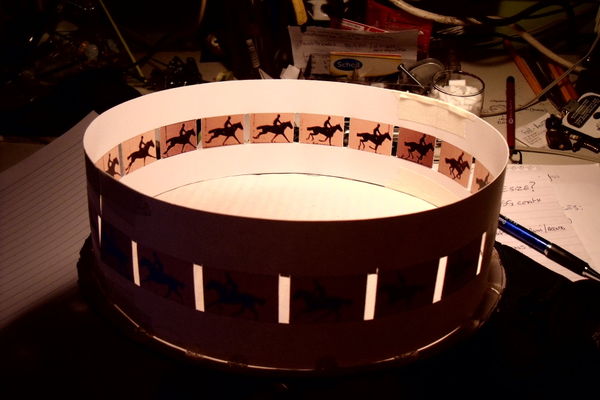Build a zoetrope
Build a zoetrope using a paper cylinder, slits, and spinning base. Draw sequential images to observe animated motion and learn persistence of vision.



Step-by-step guide to build a zoetrope
How to make a Zoetrope animation in 3D
Step 1
Clear a work area and lay out all your materials where you can reach them.
Step 2
Cut two long strips from the cardstock each about 8 cm tall and about 25 to 30 cm long.
Step 3
On one strip cut 12 evenly spaced vertical slits about 1 cm long near the top edge.
Step 4
On the other strip draw 12 small side by side frames across its length for your animation.
Step 5
In each frame draw the same simple character moving a little more each time to make a motion sequence.
Step 6
Colour your drawings using the colouring materials.
Step 7
Curve the slit strip into a circle and tape the ends to make the outer cylinder.
Step 8
Curve the picture strip into a ring and tape the ends to make the inner image band.
Step 9
Place the image band inside the slit cylinder so the drawings face inward and sit near the bottom.
Step 10
Tape the image band to the inside bottom of the outer cylinder so it stays in place.
Step 11
Center the finished cylinder on the paper plate.
Step 12
Tape the cylinder's bottom edge to the paper plate so the plate and cylinder will spin together.
Step 13
Spin the plate steadily with your finger.
Step 14
Look through the slits while it spins to watch the drawings turn into animated motion and then share your finished zoetrope on DIY.org.
Final steps
You're almost there! Complete all the steps, bring your creation to life, post it, and conquer the challenge!


Help!?
What can I use if I don't have cardstock or a paper plate?
If you don't have cardstock, cut strips from a cereal-box or thin cardboard about 8 cm tall and 25–30 cm long for the bands, and use a stiff jar lid or a cardboard circle cut from a box in place of the paper plate, using masking tape if you don't have clear tape.
My zoetrope doesn't show a smooth animation—what might be wrong and how do I fix it?
If the motion is blurry or skips, ensure the 12 vertical slits are evenly spaced and about 1 cm long near the top (step 3), the image strip faces inward and is taped near the bottom of the cylinder (steps 5–6), the cylinder is centered and taped firmly to the plate (steps 9–10), and spin the plate steadily with your finger (step 11).
How can I adapt this project for younger or older kids?
For younger children, pre-cut the two strips and the slits and have them draw or place six large simple frames (steps 2–4), while older kids can draw 16–24 smaller frames for smoother motion and add detailed coloring or a motorized spinner for steadier rotation (steps 4, 11).
How can we personalize or improve the zoetrope for a more advanced result?
To enhance the zoetrope, add more frames on the picture strip for smoother animation, decorate or tape a background scene to the inside of the outer cylinder, try translucent paper with an LED under the plate for lighting, or mount the cylinder on a battery-powered spinner so it rotates steadily before you share it on DIY.org (steps 4, 6, 9, 11, final step).
Watch videos on how to build a zoetrope
Zoetrope | How to make Zoetrope | Classic Paper Animation | Optical Illusion
Facts about animation and persistence of vision
📚 Flip books use the same basic idea: a rapid sequence of drawings that your thumb flips into motion, and many early animators trained with them.
🎬 Movies typically run at 24 frames per second, but simple zoetropes can show convincing motion with as few as 12–16 frames.
👁️ The illusion of motion comes from persistence of vision — your eyes and brain blend quickly changing images into what looks like continuous movement.
🕳️ The slits in a zoetrope act like tiny shutters, letting your eye catch each frame separately so the sequence appears smooth when spun.
🎞️ The zoetrope was invented in the 1830s by William George Horner and became a popular Victorian optical toy.
How do I build a zoetrope to see animated motion?
What materials do I need to build a paper zoetrope?
What ages is a zoetrope activity suitable for?
What are the benefits, safety tips, and fun variations for a zoetrope?


One subscription, many ways to play and learn.
Only $6.99 after trial. No credit card required


